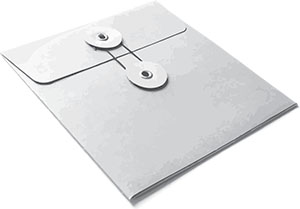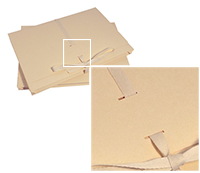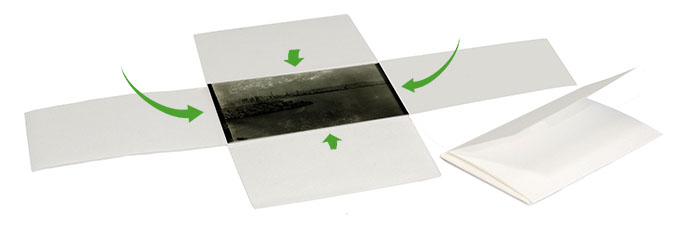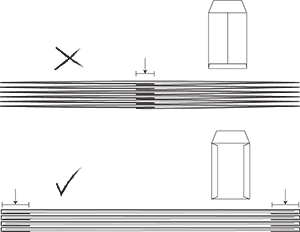
A riveting post on paper enclosures
Paper or card enclosures can be great for archival storage, but some storage enclosures could be putting the enclosed documents at risk through their design.
Probably best not to keep it buttoned
There are some paper enclosures that we don’t sell – but we do get asked for. One of those would be designs with button and string fasteners which are common on folders and envelopes (pictured, right).
In isolation they look innocuous, but the rivets holding the buttons in place present a major risk to contents should any pressure be applied by stacking, or friction in transport. These folders and envelopes cannot be safely stacked as the rivet creates a pressure point on the contents, they just aren’t practical or safe in an archive setting. If you are using this type of folder or envelope we advise you investigate an alternative.

So, what should I use? A good alternative would be one of our archival folders secured with archival cotton tying tape, see the image an example. The folders shown have pre-cut slits for the cotton tying tape, convenient but not necessary, you can view more details on the archival expansion folders here. The best folder is one that protects from damage and provides access to the contents making handling easier and therefore reducing the risk of accidental damage.

'4-flap' folders and envelopes are able to open completely, meaning that contents can be removed/replaced easily with access to all sides. We have a large range of acid free '4-flap' archival folders and envelopes suitable for documents and photographs, click here to see the range of '4-flap' folders and envelopes. Four flap envelopes and folders are a fairly simple design and can be custom made from archival materials to suit your item if a stock size isn't suitable.
Logo, no-go
We are very proud of our brand, but we don’t emboss our folders or envelopes with it, even though some are made exclusively by us or for us. Although nowhere near as aggressive as a metal rivet, embossing can also cause uneven pressure which could be in direct contact with delicate contents, especially when stacked.
embossing can also cause uneven pressure which could be in direct contact with delicate contents, especially when stacked.
Seams a good idea?
Continuing on the same theme, seam position, such as one along the centre or one at the side, can also cause uneven pressure on stored documents. Our archival envelopes have a two external side seams to equalise the load, this also allows them to stack evenly. See the illustration to the right.
Why use a paper enclosure for archival storage at all?

Good quality acid-free archival paper enclosures offer a few benefits over polyester or polyethylene which can make them more suitable in some archival storage applications.
Here are some of the reasons you may choose paper storage:
- Paper is porous and allows documents to breathe, this prevents gasses from becoming trapped, and allows moisture to escape. Trapped moisture can cause mould and mildew to form which if left untreated could stain the object and attract pests, as well as potentially adhering to the enclosure in the case of some photographs.
- Archival paper enclosures also offer the additional option of buffering. The additional buffering agent, usually calcium carbonate, which is added to the paper pulp, helps to neutralise acids in the storage environment that would damage the stored object. You can read more about buffered and unbuffered storage here.
- Paper is opaque and blocks light, this is excellent protection from UV, but does mean that viewing the contents is more difficult and could increase handling.
- Some plastics such as polyester can carry a static charge, which can be an advantage in retaining contents, however, friable surfaces may be damaged by static and be more suited to a paper enclosure.
- Paper is a low static material which may suit friable surfaces that may be susceptible to damage from static.
If you are in any doubt over which type of enclosure is suitable for your collection it is always best to consult the advice of a qualified conservator.